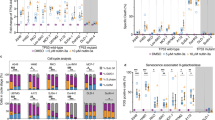Abstract
When resting human cells are activated in media containing BrdU, thymidine residues are replaced by the halogenated analogue during semiconservative DNA replication. BrdU substitution leads to diminished fluorescence if these cells are stained with the fluorochrome Hoechst 33258. This is a principle familiar to cytogeneticists employing the differential metaphase staining technique for sister chromatid exchange (SCE) analysis (Latt 1973). By measuring the amount of Hoechst dye quenching after BrdU incorporation in a flow cytometer, one can literally count the number of times a cell has divided in the presence of BrdU (Kubbies and Rabinovitch 1983). The use of a second, BrdU-independent dye (e.g., ethidium bromide) permits the simultaneous recording of quenched and unquenched fluorescence (the latter, of course, reflecting the regular 2 c to 4 c oscillations of DNA content as cells replicate and divide). Figure 1 shows examples of such a bivariate (Hoechst fluorochrome vs. ethidium bromide) fluorescence analysis. The informational content of this type of analysis is unique since it resolves cell-cycle phase fractions throughout three successive cell cycles. By electronic framing, rotation, and projection onto the Hoechst axis, the component phases of each individual cell cycle can be separately displayed: they are then amenable to analysis by conventional curve fitting techniques (bottom panels in each figure). In the example of a 72 h phytohemagglutinin (PHA)-stimulated peripheral blood-lymphocyte culture from a healthy donor (Fig. 1 a), the cell cycle distribution of a total of 91944 cells was recorded and analyzed by curve fitting.
Supported by Deutsche Forschungsgemeinschaft grant Ho 849/2 − 1 and National Institutes of Health grant AG - 01751
Access this chapter
Tax calculation will be finalised at checkout
Purchases are for personal use only
Preview
Unable to display preview. Download preview PDF.
Similar content being viewed by others
References
Balin AK, Goodman DPB, Rasmussen H, Cristofalo VJ (1978) Oxygen-sensitive stages of the cell cycle of human diploid cells. J Cell Biol 78: 390
Bors W, Saran M, Czapski G (1980) In: Bannister HW, Bannister JV (eds) Biological and clinical aspects of superoxide and superoxide dismutase. Elsevier/North Holland, New York, p 337
Dutrillaux B, Aurias A, Dutrillaux AM et al. (1982) The cell cycle of lymphocytes in Fanconi anemia. Hum Genet 62: 327
Joenje H, Arwert F, Eriksson AW, De Koning H, Oostra AB (1981) Oxygen-dependence of chromosomal aberrations in Fanconi’s anaemia. Nature 290: 142
Hollstein MC, Brooks P, Linn S, Ames BN (1984) Hydroxymethyluracil DNA glycosylase in mammalian cells. Proc Natl Acad Sci USA 81: 4003
Kubbies M, Rabinovitch PS (1983) Flow cytometric analysis of factors which influence the BrdUrd-Hoechst quenching effect in cultivated human fibroblasts and lymphocytes. Cytometry 3: 276
Kubbies M, Schindler D, Hoehn H, Rabinovitch PS (1985 a) Cell cycle kinetics by BrdU-Hoechst flow cytometry: an alternative to the differential metaphase labelling technique. Cell Tissue Kinet 18: 551
Kubbies M, Schindler D, Hoehn H, Schinzel A, Rabinovitch PS (1985 b) Endogenous blockage and delay of the chromosome cycle despite normal recruitment and growth phase explain poor proliferation and frequent edomitosis in Fanconi anemia cells. Am J Hum Genet 37: 1022
Latt SA (1973) Microfluorometric detection of deoxyribonucleic acid replication in human metaphase chromosomes. Proc Natl Acad Sci USA 70: 3395
Latt SA, Kaiser TN, Lojewski A et al. (1982) Cytogenetic and flow cytometric studies of cells from patients with Fanconi’s anemia. Cytogenet Cell Genet 33: 133
Mavelli I, Ciriolo MR, Rotilio G et al (1982) Superoxide dismutase, glutathione peroxidase and catalase in oxidative hemolysis. Biochem Biophys Res Commun 106: 286
Packer L, Fuehr K (1977) Low oxygen concentration extends the lifespan of cultured human diploid cells. Nature 267: 423
Poot M, Verkerk A, Koster JF, Jongkind JF (1986) De novo synthesis of glutathione in human fibroblasts during in vitro ageing and in some metabolic diseases as measured by a flow cytometric method. Biochim Biophys Acta 833: 580
Rabinovitch PS (1983) Regulation of human fibroblast growth rate by both noncycling cell fraction and transition probability is shown by growth in 5-bromodeoxyuridine followed by Hoechst 33258 flow cytometry. Proc Natl Acad Sci USA 80: 2951
Salk D, Bryant E, Hoehn H, Johnston P, Martin GM (1985) In: Salk D, Fujiwara Y, Martin GM (eds) Werner’s syndrome and human aging. Plenum, New York, p 305
Scarpa M, Rigo A, Momo F et al. (1985) Increased rate of superoxide ion generation in Fanconi anemia erythrocytes. Biochem Biophys Res Commun 130: 127
Schindler D, Kubbies M, Hoehn H, Schinzel A, Rabinovitch PS (1985) Presymptomatic diagnosis of Fanconi’s anaemia. Lancet 1: 937
Schindler D, Hoehn H (1988) Fanconi anemia mutation causes cellular. Susceptibility to ambient oxygen. Am J Hum Gent (in press)
Taylor WG, Camalier RF, Sanford KK (1978) Density-dependent effects of oxygen on the growth of mammalian fibroblasts in culture. J Cell Physiol 95: 33
Weksberg R, Buchwald M, Sargent P, Thompson MW, Siminovitch L (1979) Specific cellular defects in patients with Fanconi anemia. J Cell Physiol 101: 311
Editor information
Editors and Affiliations
Rights and permissions
Copyright information
© 1989 Springer-Verlag Berlin Heidelberg
About this chapter
Cite this chapter
Hoehn, H., Kubbies, M., Schindler, D., Poot, M., Rabinovitch, P.S. (1989). BrdU-Hoechst Flow Cytometry Links the Cell Kinetic Defect of Fanconi Anemia to Oxygen Hypersensitivity. In: Schroeder-Kurth, T.M., Auerbach, A.D., Obe, G. (eds) Fanconi Anemia. Springer, Berlin, Heidelberg. https://doi.org/10.1007/978-3-642-74179-1_13
Download citation
DOI: https://doi.org/10.1007/978-3-642-74179-1_13
Publisher Name: Springer, Berlin, Heidelberg
Print ISBN: 978-3-642-74181-4
Online ISBN: 978-3-642-74179-1
eBook Packages: Springer Book Archive




